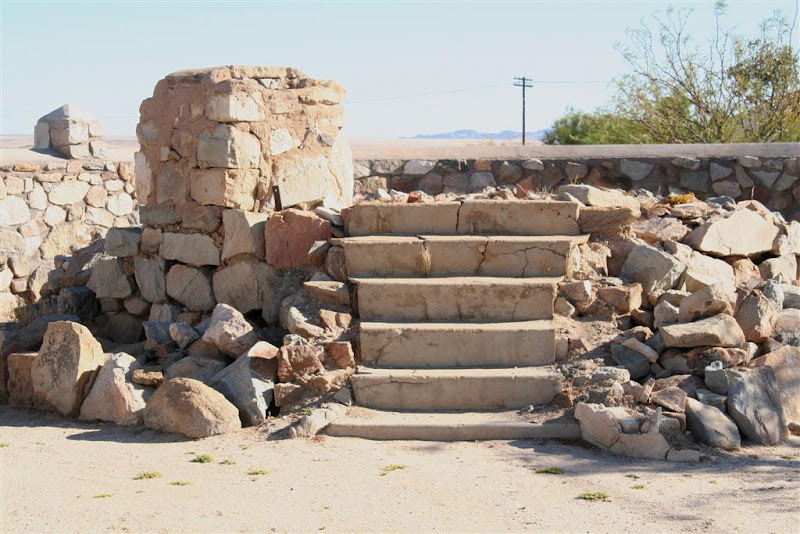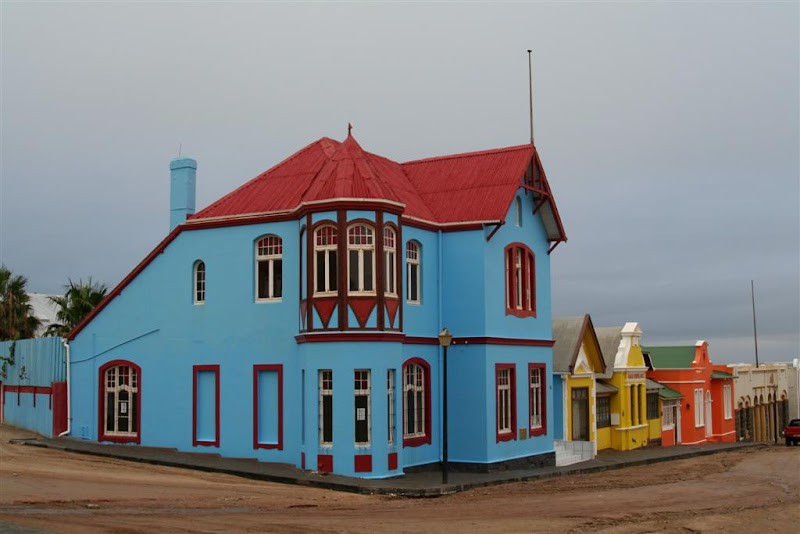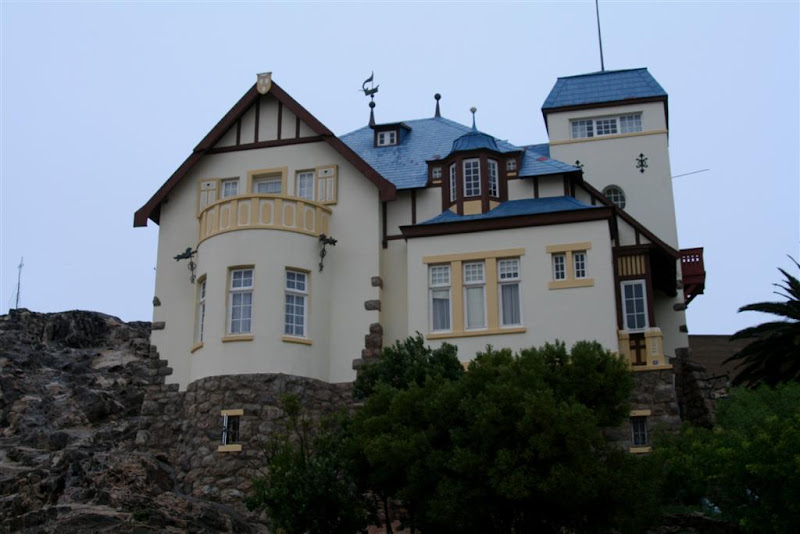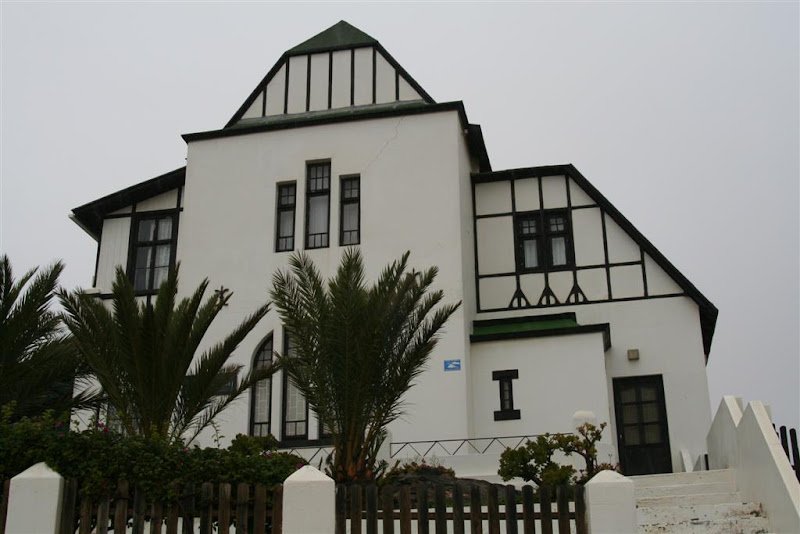skip to main |
skip to sidebar
Kolmannskuppe is a Ghost Town in southern Namibia, a few kilometres inland from the port of Lüderitz.
It was a small mining village and is now a popular tourist destination run by the diamond-mining company NAMDEB. The town was named after a transport driver named Johnny Coleman who, during a sand storm, abandoned his ox wagon on a small incline opposite the settlement - Kolmannskuppe in German and, the generally used name, Kolmanskop, in Afrikaans.
The town was named after a transport driver named Johnny Coleman who, during a sand storm, abandoned his ox wagon on a small incline opposite the settlement - Kolmannskuppe in German and, the generally used name, Kolmanskop, in Afrikaans. The town developed after the discovery of diamonds in the area in 1908 - which led to a "Diamond Rush".
The town developed after the discovery of diamonds in the area in 1908 - which led to a "Diamond Rush".
The rush lead to the establishment of a busy little German-style village, served by a general dealer, butchery, bakery, furniture factory, soda-water and lemonade plant, daily ice and milk deliveries, 4 skittle alleys, a public playground and swimming pool, a grand community centre complex complete with a theatre and an orchestra that played at tea dances, until well after the sun had set. The discovery of diamonds saw the amazing sight of lines of men, crawling through the desert by the light of a full moon, sifting the sand beneath them for diamonds.
The discovery of diamonds saw the amazing sight of lines of men, crawling through the desert by the light of a full moon, sifting the sand beneath them for diamonds.
Subsequently, the German authorities declared the land 'forbidden territory' or Sperrgebiet, awarding the Deutsche Diamanten Gesellschaft (DDG) the sole prospecting rights.
The town declined after World War I when the diamond-field slowly exhausted and was ultimately abandoned in 1954. The geological forces of the desert mean that tourists now walk through houses knee-deep in sand.
The geological forces of the desert mean that tourists now walk through houses knee-deep in sand.
Kolmanskop is popular with photographers for images of the desert sands reclaiming this once-thriving town - it has also been used as a set for movies and TV series. The Bookkeeper's house - a most important job when Kolmanskop was producing millions of Deutchmarks worth of diamonds.
The Bookkeeper's house - a most important job when Kolmanskop was producing millions of Deutchmarks worth of diamonds.
The top officials lived in grand style and, it seems, life was pretty good for all, except probably the labourers. An old Bathtub makes an escape on a sea of sand in front of The Teacher's house.
An old Bathtub makes an escape on a sea of sand in front of The Teacher's house. There's no stopping the sand, slowly but surely it prevails.
There's no stopping the sand, slowly but surely it prevails. One of the crumbling houses with a view over the Desert.
One of the crumbling houses with a view over the Desert. A garage close to the Mine Manager's house - I wonder what grand old Auto it once housed - now it shelters only sand.
A garage close to the Mine Manager's house - I wonder what grand old Auto it once housed - now it shelters only sand. Exposed bricks where the abrasive wind has worn away the plaster.
Exposed bricks where the abrasive wind has worn away the plaster. The Mine Manager's house.
The Mine Manager's house.
In 1980, a number of buildings were restored and more followed with the advent of Namibia as a premier tourist destination.
More pics in my Picasa Album
Related Post: Colonial Architecture Of Lüderitz
References:
Wikipedia
Namibian.org
.
A few Strange Structures I've seen in the Desert: This colourful shelter stands alongside the gravel road, a few kilometres north of the tiny outpost at Solitaire.
This colourful shelter stands alongside the gravel road, a few kilometres north of the tiny outpost at Solitaire.
I love the bright Earthy colours against the desert pastels. Although it does not look neglected, I've never seen any sign of life there and wonder who constructed it and why.
Although it does not look neglected, I've never seen any sign of life there and wonder who constructed it and why.
Perhaps someone built it as a holiday home, an escape, or perhaps it was built as accommodation for travellers - I'll try to find out when I'm next in the area. What makes this structure unusual is that it has been built using glass bottles laid flat into the walls - there's even a giant bottle perched on the little 'tower' on the roof.
What makes this structure unusual is that it has been built using glass bottles laid flat into the walls - there's even a giant bottle perched on the little 'tower' on the roof.
I'd love to stand inside and see what the effect is with light entering through the bottles. I've been watching the lack of progress in the building of this solitary rock house for almost ten years now.
I've been watching the lack of progress in the building of this solitary rock house for almost ten years now.
It stands besides the main highway between Keetmanshoop and Goageb, close to the Fish River Bridge.
When I first encountered it it was not covered and about five years ago a thatched roof suddenly appeared - nothing else has happened since then. Again, I must wonder at the purpose of the structure, stuck uncompleted in the middle of nowhere.
Again, I must wonder at the purpose of the structure, stuck uncompleted in the middle of nowhere.
What I find charming about this double-storey house, (besides that it's built of rock), is that the walls are not exactly straight, they seem to blossom outwards slightly towards the top.
 The the 'Le Mirage Desert Lodge And Spa' close to Sossusvlei.
The the 'Le Mirage Desert Lodge And Spa' close to Sossusvlei.
When I first saw these buildings they offended my eye.
It's not that they're unattractive or clash much with the environment - I think I was upset, (after travelling through miles of 'free' space), at the realisation that even the Desert is 'owned' ...
- or perhaps I was just a grumpy old man that day. A closer look at Le Mirage's guest rooms - soft earthy colours with rocks built into the wall over the windows.
A closer look at Le Mirage's guest rooms - soft earthy colours with rocks built into the wall over the windows.
What I like most though, is that the structure isn't regular - no straight lines, but not wacky either.
I can't afford to take a look at the insides of the rooms ...
 This approximately 12m tall Rock Tower stands close to the road between Ariamsvlei and Karasburg. The walls are absolutely straight - that takes some skill on a round building.
This approximately 12m tall Rock Tower stands close to the road between Ariamsvlei and Karasburg. The walls are absolutely straight - that takes some skill on a round building.
This is what I first fantasised about for the en suite bathroom of the house, complete with Sunset Jacuzzi on top - thank heavens I came to my senses.
I was told by a Karasburg resident that the farmer had built it as a Watch Tower to deter game poachers - quite a few farmers in Namibia build smaller watch towers. I love the contrasts in this derelict building in the middle of nowhere - it would make a great subject at sunrise or set, or after it's rained.
I love the contrasts in this derelict building in the middle of nowhere - it would make a great subject at sunrise or set, or after it's rained.
If only walls could talk - What possessed someone to live in such isolation so long ago?
It's like a Sandcastle returning to the Earth.
.
I awoke early in Warmbad and went out looking for images in the rising Sun: Three churches dominate the Warmbad skyline - this rock structure was built by the Rhenish Missionary Society in 1877.
Three churches dominate the Warmbad skyline - this rock structure was built by the Rhenish Missionary Society in 1877.
The first European style buildings, including a church, were built between 1805 and 1810, by Christian and Abraham Albrecht from the London Missionary Society, thereby establishing the first mission station in South-West Africa, (pre-independence Namibia). This derelict building stands in Warmbad's 'main street'.
This derelict building stands in Warmbad's 'main street'.
Through Wikipedia I found the photo below, taken between 1908 and 1914 and which appears to show the building above in better days: Donkey cart in front of the Warmbad S.A. Territories Ltd building, early 20th century.
Donkey cart in front of the Warmbad S.A. Territories Ltd building, early 20th century.
At this time Warmbad lost its original importance as a stop-over for travellers, being bypassed by railway connections and new road construction - many of the buildings began to decay. A liquor store - or "Bottle Store" as they're known in Southern Africa - one of only two shops I saw in Warmbad, the other is a small general store.
A liquor store - or "Bottle Store" as they're known in Southern Africa - one of only two shops I saw in Warmbad, the other is a small general store.
Alcohol abuse is the root cause of many of Namibia's many social evils - it is not only a problem amongst the poor, but the wealthy as well.
The majority of Warmbad's inhabitants live in abject poverty. There is no industry in the area, residents survive from old-age pensions and subsistence goat farming.
 An old disused public Telephone Box outside the Post Office - I haven't seen one of these in ages.
An old disused public Telephone Box outside the Post Office - I haven't seen one of these in ages. Another decaying building - there are many of these old and interesting structures in Warmbad but it seems that not much effort is being made to preserve them.
Another decaying building - there are many of these old and interesting structures in Warmbad but it seems that not much effort is being made to preserve them.
Walking around Warmbad I saw many opportunities for developing the historical aspect of the settlement in order to attract tourists and revenue to the area - there is a museum and guided tours but there's so much more that can be done.  A common type of Namibian shelter, corrugated sheets nailed to a wooden frame - the residents of this dwelling have electric power and are able to afford satellite TV.
A common type of Namibian shelter, corrugated sheets nailed to a wooden frame - the residents of this dwelling have electric power and are able to afford satellite TV.
I was forced to question my perceptions when a German woman I met there - apparently on a Mission to assist the people of Warmbad - related that she was shocked once to see four young boys kill a tiny bird then cook and devour it between themselves.
She assumed that the kids were starving.
My perception of the incident would have been that the kids, having no other form of entertainment, were doing what rural kids do, playing outside, with hunting being one of their activities ...
... and as for four of them sharing one tiny bird - that's the culture of the Poor, they share what food they have, no matter how little.
 People were starting to rise and I spotted two young women carrying their water containers to a communal water point - this is the daily reality of millions of people not only throughout Africa but, I suspect, in many other countries around the world.
People were starting to rise and I spotted two young women carrying their water containers to a communal water point - this is the daily reality of millions of people not only throughout Africa but, I suspect, in many other countries around the world.
I can't believe that these frail-looking girls carry those full containers home without assistance - I doubt that I could carry one container for more than a few meters.
The bliss of having water on tap ...
 The rock entrance gate of a German colonial fort which now serves as the entrance to the Police Station.
The rock entrance gate of a German colonial fort which now serves as the entrance to the Police Station.
After Imperial Germany declared its territorial rights over South-West Africa, a fort was built in Warmbad in 1905 and Schutztruppe soldiers were stationed at the settlement to counter the Herero and Nama uprising. The old German Garrison Hospital, adjacent to the Doctor's house shown in the previous Warmbad post.
The old German Garrison Hospital, adjacent to the Doctor's house shown in the previous Warmbad post.
 My first (fuzzy) picture of an Owl - This Barn Owl lives in the old hospital and flew off as I approached.
My first (fuzzy) picture of an Owl - This Barn Owl lives in the old hospital and flew off as I approached.
I don't know exactly why, but I feel compelled to revisit Warmbad as soon as possible ... maybe it's the lure of the Owl and the many other birds of prey I saw there ... or perhaps I have a 'higher' purpose to serve there ...
Nah, I'm too old for going on missions ...Related Post: Southeast Namibia: Warmbad Pt 1
References:
Wikipedia
Dr Klaus Dierks
.
Towards the end of November I took a trip to south-eastern Namibia.
It was my first visit to the area - I had heard that it was underdeveloped but was not prepared for the poverty I found there. Our first stop was Warmbad, a depressed settlement on the Homs River.
Our first stop was Warmbad, a depressed settlement on the Homs River.
Warmbad was known to the Nama people for centuries as |Aixa-aibes and was first named in 1760 by scout Jacobus Coetzee, the first documented European to cross the Oranje River into the South-West African territory that today forms the state of Namibia.
'Warmbad' means 'hot bath' in Afrikaans and German and refers to the hot spring around which the settlement is located. One of the first intact buildings I saw was this shebeen - Para-dise, which started the Dylan song, 'The Ballad of Frankie Lee and Judas Priest' playing in my head:
One of the first intact buildings I saw was this shebeen - Para-dise, which started the Dylan song, 'The Ballad of Frankie Lee and Judas Priest' playing in my head:
“Eternity ?” said Frankie Lee
With a voice as cold as ice
“That’s right”, said Judas Priest, “Eternity
Though you might call it Paradise” The community-owned camp-site is sub-standard and unattractive so we chose to rather stay in the bungalows which were decent and not too expensive.
The community-owned camp-site is sub-standard and unattractive so we chose to rather stay in the bungalows which were decent and not too expensive.
Pictured above are two of the single bungalows. Stairway to Paradise?
Stairway to Paradise?
Some of the oldest buildings and ruins in Namibia are to be found in Warmbad - built by Missionaries in the early 1800's. At the Hot Spring close to the Camp Site a bath has been built, housed in a fancy building but, the place is closed.
At the Hot Spring close to the Camp Site a bath has been built, housed in a fancy building but, the place is closed.
Some kids had gained entrance through an open window and were frolicking in the water.
It's my understanding that various Governments and aid organisations have donated millions to the Warmbad community so that they can improve facilities and attract tourists to this historically important area but, for reasons unknown to me, they just don't seem to be able to get their act together. Around sunset, I took a walk around the area to see what I could capture in the magic light.
Around sunset, I took a walk around the area to see what I could capture in the magic light.
A goat kid jumps off a wall. There are many goats here - they seem to be the only animals that thrive and are an important source of food and revenue for the community. I was pleasantly surprised to find the largest concentration of Aloe garipensis I've seen, in the rocks adjoining the camp-site - there are hundreds and they were glowing bright red in the setting sun.
I was pleasantly surprised to find the largest concentration of Aloe garipensis I've seen, in the rocks adjoining the camp-site - there are hundreds and they were glowing bright red in the setting sun.
 Ruins - the camp-site and bungalows are to the left of the palm trees - in the distance, the desolate, flat landscape.
Ruins - the camp-site and bungalows are to the left of the palm trees - in the distance, the desolate, flat landscape.
 I was fascinated by this old rock building - not only because it had no windows and only one locked entrance, but also for the way the builders had constructed the roof with rocks too ... I wonder what purpose the building served?
I was fascinated by this old rock building - not only because it had no windows and only one locked entrance, but also for the way the builders had constructed the roof with rocks too ... I wonder what purpose the building served? The Doctor's house adjoining the old hospital - a relic of the German Colonial era - I took many pics here.
The Doctor's house adjoining the old hospital - a relic of the German Colonial era - I took many pics here.
 After the sun had set this bird of prey, which had been roosting in the old hospital, hovered over me indignantly at being disturbed. I've identified it - probably incorrectly - as a Rock Kestrel.
After the sun had set this bird of prey, which had been roosting in the old hospital, hovered over me indignantly at being disturbed. I've identified it - probably incorrectly - as a Rock Kestrel.
Unfortunately, being hung-up on taking pics of the ruins I'd forgotten to change my ASA settings and the image turned out fuzzy.
References:
Wikipedia
Dr. Klaus Dierks.



 OneStonedCrow PicsLüderitz is a harbor town in southern Namibia, lying on one of the least hospitable coasts in Africa.
OneStonedCrow PicsLüderitz is a harbor town in southern Namibia, lying on one of the least hospitable coasts in Africa.
It was founded in 1883 when Heinrich Vogelsang purchased Angra Pequena and some of the surrounding land on behalf of Adolf Lüderitz, a hanseat from Bremen in Germany, from the local Nama chief.
Lüderitz began its life as a trading post, with other activities in fishing and guano-harvesting. In 1909, after the discovery of diamonds nearby, Lüderitz enjoyed a sudden surge of prosperity. Today, however, diamonds are mostly found elsewhere and offshore, and Lüderitz has lost a lot of this interest.
The town is known for its colonial architecture, including some Art Nouveau work, and for wildlife including seals, penguins, flamingos and ostriches.
More of my pics of Lüderitz here.
.










































